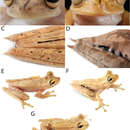Boana maculateralis: Brief Summary
provided by wikipedia EN
The stained tree frog (Boana maculateralis) is a frog in the family Hylidae endemic to Ecuador, Colombia, and Peru. Scientists have seen it between 186 and 354 meters above sea level.
This is a medium-sized frog with large eyes and large climbing disks on its toes. The adult male frog measures 31.9 to 39.2 mm in snout-vent length and the adult female frog is 32.0 to 55.3 mm. It has light brown skin with darker marks. Some individuals have a single line from the head to the middle of the back. Some indidivudals have small brown spots. Larger females have blue coloration on their flanks. Males have lighter or white coloration on their flanks. This frog has prominent spikes near its vent.
This frog is sympatric with Boana calcarata, Boana alfaroi, Boana calcarata, and possibly Boana tetete.
This frog is nocturnal. It lives in forests. Scientists have observed it perched on plants 2 meters above the ground.
The Latin name of this frog means "stains on its sides."
- license
- cc-by-sa-3.0
- copyright
- Wikipedia authors and editors
Description
provided by Zookeys
Adult male, 36.16 mm SVL, foot length 14.33 mm, head length 8.98 mm, head width 11.71 mm, eye diameter 4.07 mm, tympanum diameter 2.44 mm, tibia length 20.29 mm, femur length 18.44 mm, calcar length 1.44 mm, arm length 6.36 mm, eye-nostril distance 2.86 mm, head wider than long and wider than body; snout rounded in lateral view, truncate in dorsal view; distance from nostril to eye shorter than diameter of eye; canthus rostralis indistinct, rounded; loreal region concave; internarial area convex; nostrils not protuberant, directed laterally; interorbital area slightly convex; eye large, strongly protuberant; diameter of eye 1.7 times diameter of tympanic annulus; tympanum concealed beneath skin;tympanic annulus evident, ovoid, longer dorsoventrally and concealed dorsally by supratympanic fold, separated from eye by ca. 1.1 times its diameter; posterior end of supratympanic fold reaches anterior border of arm insertion. Arm slender, axillary membrane absent; indistinct low tubercles along ventrolateral edge of forearm; relative length of fingers I
- license
- cc-by-3.0
- copyright
- Marcel A. Caminer, Santiago R. Ron
- bibliographic citation
- Caminer M, Ron S (2014) Systematics of treefrogs of the Hypsiboas calcaratus and Hypsiboas fasciatus species complex (Anura, Hylidae) with the description of four new species ZooKeys 370: 1–68
- author
- Marcel A. Caminer
- author
- Santiago R. Ron
Distribution
provided by Zookeys
Hypsiboas maculateralis inhabits the Amazon basin of Ecuador (Napo, Orellana, Pastaza, and Sucumbíos provinces) and Peru (Región de Madre de Dios) (Fig. 17). Localities with known elevation range vary between 186 and 354 m of elevation. The elevation of Comunidad Santa Rosa (354 m) is the highest known and Santa Teresita (186 m) is the lowest.
All the specimens in Zábalo, Reserva Cuyabeno, Santa Teresita, Bataburo Lodge, and km 74 Pompeya-Iro road were found at night, in primary or secondary forests, perching on vegetation between 40 and 200 cm above the ground, in areas of pasture and flooded forest.
Vegetation types for Ecuadorian localities are: (1) Amazonian Lowland Evergreen Forest, characterized by high plant alpha-diversity and a canopy of 30 m with emergent trees that reach 40 m, (2) Floodplain Lowland Forest of White-Waters, characterized by periodical flooding with white-waters from large rivers, the vegetation reaches 35 m of height, and there are several horizontal strata of vegetation, and (3) Lowland Forest of Palms and black-waters, swamps characterized by a canopy of 30 m with dens e understory and a dominance of the palm Mauritia flexuosa.
Vegetation type of the Peruvian locality is Southwest Amazon Moist Forest.
- license
- cc-by-3.0
- copyright
- Marcel A. Caminer, Santiago R. Ron
- bibliographic citation
- Caminer M, Ron S (2014) Systematics of treefrogs of the Hypsiboas calcaratus and Hypsiboas fasciatus species complex (Anura, Hylidae) with the description of four new species ZooKeys 370: 1–68
- author
- Marcel A. Caminer
- author
- Santiago R. Ron

